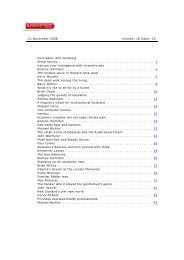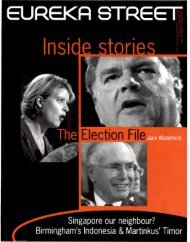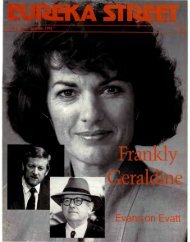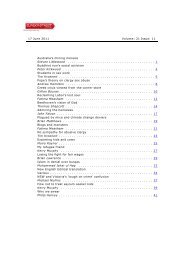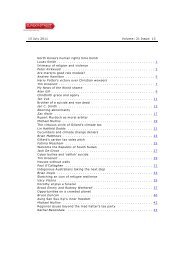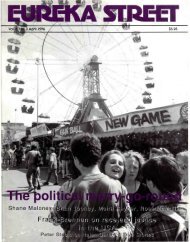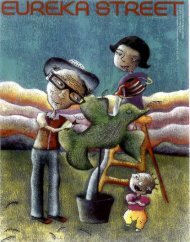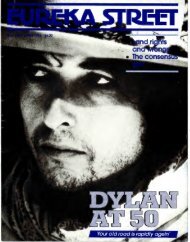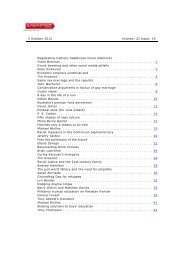25 January 2008 - 1 February 2008 Volume: 18 Issue: 2 Cricket ...
25 January 2008 - 1 February 2008 Volume: 18 Issue: 2 Cricket ...
25 January 2008 - 1 February 2008 Volume: 18 Issue: 2 Cricket ...
You also want an ePaper? Increase the reach of your titles
YUMPU automatically turns print PDFs into web optimized ePapers that Google loves.
Aboriginal art before it became an industry<br />
ES CLASSIC<br />
Rosemary Crumlin<br />
<strong>Volume</strong> <strong>18</strong> <strong>Issue</strong>: 2<br />
<strong>25</strong> <strong>January</strong> <strong>2008</strong> - 1 <strong>February</strong> <strong>2008</strong><br />
The following excerpt is from an article that appeared in<br />
Eureka Street— volume 1, number 1, back in March 1991. In it,<br />
Rosemay Crumlin recalls travelling in search of Aboriginal<br />
Christian art for an exhibition to coincide with the World Council<br />
of Churches Assembly. She was joined on her pilgrimage by<br />
exhibition co-curator Anthony Waldegrave-Knight and the<br />
project’s conceiver, Frank Brennan, then director of the Jesuit<br />
research and social action agency Uniya.<br />
Our first journey into the outback was full of adventure,<br />
incredible 49-degree heat, and quite a lot of disillusion. You see,<br />
part of the process involved visiting remote Aboriginal<br />
communities to see whether we could discover any art that gave<br />
evidence that people were re-thinking Christianity in their own<br />
symbolic system. And what Christian art we did find was often as<br />
bad as I’d expected.<br />
But at Balgo, in the Central Desert, we came across some huge<br />
wall-hangings and panels rolled up in the church the people there use for liturgies. I<br />
knew we were at the edge of something. But the heat was terrible and Anthony and I<br />
and even Frank (who looks like God, walking around in his hat) thought we’d had<br />
enough. It wouldn’t have taken much to persuade us to omit Turkey Creek from our<br />
itinerary.<br />
I rang Sister Clare Ahern at Turkey Creek, admitting to some hesitation. Her<br />
reaction was unambiguous: ‘I think you should have come here first.’ So we caught<br />
the little mail plane to Turkey Creek and arrived at the Meriingki Centre.<br />
There, on the walls, was what we had been looking for. Startling! ... absolutely<br />
knockout works from the people of the Warmun Community. But particularly<br />
astonishing were those of Hector Sundaloo, George Mung and Paddy Williams. These<br />
three had been Christians from way back, and now, in their late 50s or early 60s ...<br />
they are the unmistakable community leaders. Hector is regarded as a ngapuny man,<br />
©<strong>2008</strong> EurekaStreet.com.au 14



